eLearning Statistics By Adoption, Usage and Facts (2025)
Updated · Nov 10, 2025

Table of Contents
- Introduction
- Editor’s Choice
- How Many People Use Online Learning?
- Corporate eLearning
- eLearning Market Size
- Academic eLearning
- Key eLearning Trends
- Adoption of AI in eLearning
- The Lasting Impact of COVID-19 on eLearning
- eLearning Statistics by Country
- Leading eLearning Platforms
- Challenges and the Future of eLearning
- Conclusion
Introduction
eLearning Statistics: In simple terms, eLearning means electronic learning. It was coined in 1999, but the concept of using tech for education stretches back decades. Essentially, eLearning refers to any form of learning and teaching that happens over an electronic medium, whether it’s through the internet, an intranet, or even a standalone digital course.
The broad category includes a vast range of digital resources, from online college courses and K-12 virtual classrooms to corporate training modules and massive open online courses (MOOCs).
The low barrier to entry for eLearning, which requires only a device and an internet connection, has made it exceptionally accessible. In the modern world, this form of education has seen explosive growth and shows no signs of slowing down.
As we examine the data, it becomes clear that eLearning is a fundamental part of the global educational and professional landscape today. I would like to delve into the eLearning statistics that are transforming the industry, providing an in-depth look at the data driving the change. Let’s get into it.
Editor’s Choice
- The global eLearning market has surpassed $400 billion and is projected to exceed $1 trillion by 2032, a clear sign of its exponential growth.
- Corporate adoption is nearly universal, with over 90% of Fortune 500 companies using eLearning or training, and companies seeing a 42% increase in revenue as a result.
- eLearning is highly efficient, reducing training time by up to 45% and leading to a 30% higher employee retention rate compared to traditional methods.
- The COVID-19 pandemic accelerated growth, resulting in a 900% increase in global internet searches for eLearning and leading 73% of US students to express a desire to continue with online classes.
- Mobile learning is a dominant trend, with over 67% of learning occurring through mobile devices, and the mobile eLearning market is projected to reach over $70 billion by 2027.
- Gamification is a powerful engagement tool that increases learner motivation by 67% and knowledge retention by 18%.
- Platforms like Udemy and Coursera have captured massive user bases, with over 52 million and 82 million users, respectively, demonstrating the immense scale of the online course market.
- eLearning is also highly effective, with learners retaining 25 to 60% more material than in-person students, and 77% of academic leaders rating online outcomes as equal to or better.
How Many People Use Online Learning?
- According to Statista, the United States generated around USD 74.8 billion in revenue from online learning in 2023, making it the largest online learning market in the world. This strong performance highlights the country’s growing adoption of digital education platforms.
- Research published by Taylor & Francis Online reported that over 30% of American students have taken at least one online course. Many of these students also continued to attend on-campus classes, showing that hybrid learning remains a popular approach.
- According to Statista data, women slightly outnumber men in online education. In 2020, 50% of undergraduate online learners were female compared to 49% male, while among graduate students, the share was 52% female and 48% male.
- The National Center for Education Statistics reported that the number of undergraduates enrolled exclusively in online courses rose sharply from 2.4 million in 2019 to 7 million in 2020, reflecting a surge of nearly 200% during the COVID-19 pandemic.
- The same source stated that students taking one or more online courses but not exclusively online increased by 97% in 2020, emphasizing how quickly digital education expanded when physical campuses closed.
- The Report mentioned that more than 200 million learners registered for at least one Massive Open Online Course (MOOC) in 2022, compared with just 40 million in 2021. This sharp rise highlights the global reach and accessibility of digital education.
- Bay Atlantic University found that 63% of online learners chose virtual study because of its flexibility, allowing them to balance education with personal and professional responsibilities.
- The same university also reported that 30% of students pursued online degrees to secure better-paying jobs, while 23% sought careers more aligned with their interests. This shows that financial motivation remains a major factor behind online learning adoption.
- According to 99Guru, 42% of online learners are aged 30 or older, demonstrating that lifelong learning and career reskilling have become key trends among adult professionals.
- Open University research in the United Kingdom revealed that online education produces 85% fewer CO₂ emissions per student compared to traditional in-person learning. Energy use on campuses is also reduced by nearly 90%, proving that virtual learning supports both education and sustainability goals.
Corporate eLearning

- Companies that offer eLearning have seen a 21% increase in employee satisfaction, as employees feel more valued and empowered by the opportunity to grow their skills flexibly.
- A recent study revealed that employees who engage in eLearning courses have a 30% higher retention rate than those who rely solely on traditional, in-person training.
- eLearning can reduce employee training time by up to 45% compared to classroom-based methods.
- For every dollar invested in eLearning, companies can see a return of $30, largely due to increased productivity.
- The average cost for a traditional corporate training session is $1200 per employee, whereas a similar eLearning course costs approximately $150.
- It is estimated that 77% of US companies now use online training to some degree, a clear indication that it is the standard method for corporate training.
- More than 68% of employees say they prefer to learn on the job and at their own pace, a need that is met perfectly by self-paced eLearning modules.
- Companies that invest in comprehensive eLearning programs for their sales teams have reported a 35% increase in sales revenue within the first year.
- eLearning platforms used for employee onboarding have been shown to improve new hire retention rates by over 50%.
- 58% of employees prefer to learn at their own pace, a fact that makes the flexible nature of eLearning a highly attractive option for higher engagement rates.
- The average employee spends approximately 1% of their work week on training, a number that is only possible with the convenient and time-efficient nature of eLearning.
- A survey of learning and development professionals found that 87% believe that eLearning is critical to their organization’s long-term success and competitiveness.
- The corporate L&D market, valued at $28 billion in 2022, is heavily influenced by the adoption of eLearning platforms.
- A recent report found that 62% of employees believe their current company’s digital learning offerings are superior to those of their previous employers.
- Nearly 70% of corporate learning is now conducted remotely, a trend that was accelerated by recent global events but shows a clear preference for digital delivery.
- Companies that leverage eLearning for compliance training report a 45% reduction in legal and regulatory risks due to increased employee understanding and adherence to policies.
- The use of eLearning for soft skills training is effective, with 75% of surveyed employees reporting that digital training helped them improve their communication and leadership abilities.
- Organizations that use a blended learning approach, combining eLearning with in-person sessions, have reported a 28% increase in overall knowledge retention among their employees.
- More than 42% of companies that use eLearning report a noticeable increase in revenue, linking effective training directly to business growth.
- The average training budget for companies has increased by 12% year over year to accommodate the growing need for robust and engaging digital learning content.
| Increase in Employee Satisfaction | 21% |
| Employee Retention Rate Increase |
30% |
|
Cost Savings per Employee |
Up to $1050 |
| Increase in Sales Revenue |
35% |
|
Employees Preferring Self-Paced Learning |
58% |
| Increase in Knowledge Retention (Blended Learning) |
28% |
eLearning Market Size
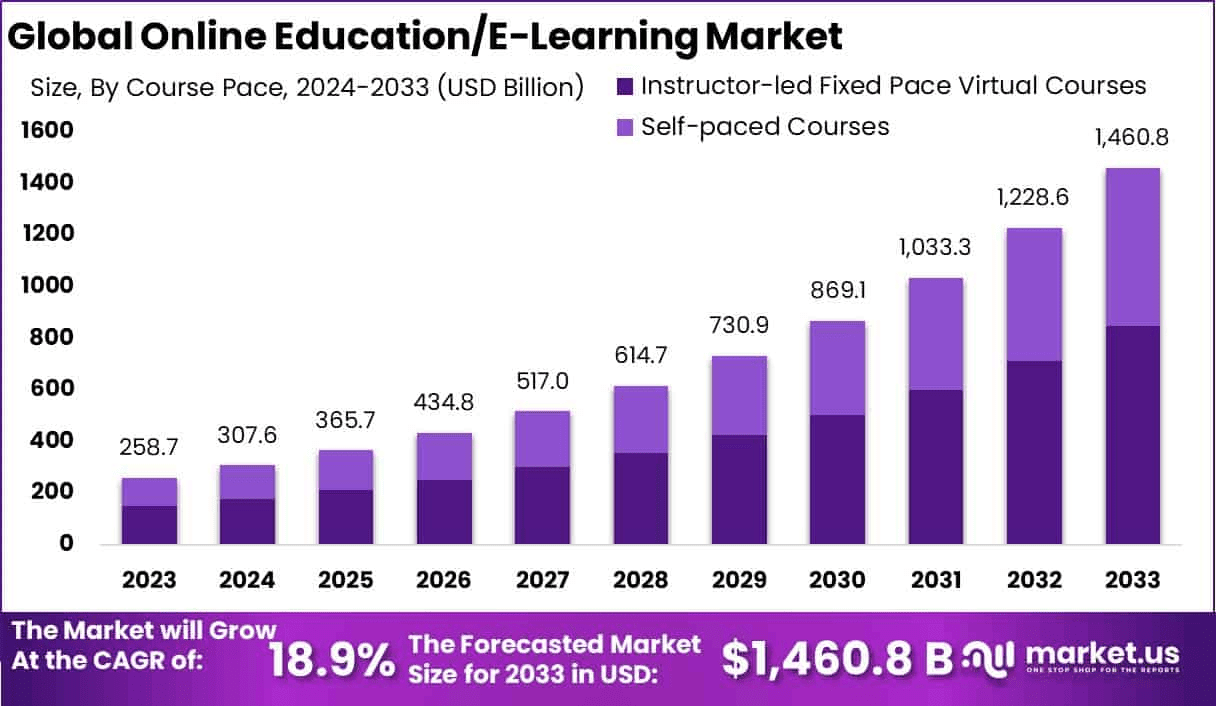
According to Market.Us, the eLearning market has become a formidable economic force, with its value swelling to hundreds of billions of dollars. This growth is a reflection of its widespread adoption and the significant value it offers across multiple sectors, from formal education to corporate development. The data reveal a robust and expanding industry that is attracting substantial investment and fundamentally changing how people learn and acquire new skills.
- The global online education or e-learning market is expected to reach USD 1,460.8 billion by 2033, increasing from USD 258.7 billion in 2023, with a CAGR of 18.9% between 2024 and 2033.
- The generative AI in the EdTech market is projected to grow from USD 268 million in 2023 to USD 8,324 million by 2033, registering a CAGR of 41%. The rapid growth highlights the strong impact of artificial intelligence in improving digital learning systems and personalized education.
- The EdTech and smart classroom market was valued at USD 146.8 billion in 2023 and is expected to reach USD 498.5 billion by 2032, growing at a CAGR of 15%. The growing use of connected devices and interactive teaching solutions primarily drives this growth.
- The broader global EdTech market is forecasted to expand from USD 146.0 billion in 2023 to USD 549.6 billion by 2033, with a CAGR of 14.2%, driven by digital transformation and advanced learning tools.
- Nearly 90% of companies now provide digital training opportunities for their employees, showing a strong trend toward corporate e-learning.
- The online learning market in Asia is growing rapidly with about 20% annual revenue growth, showing increasing interest and participation across the region.
- Approximately 49% of students worldwide have participated in online learning, while 63% of students in the United States engage in online learning activities daily.
- About 80% of global businesses now offer online learning or virtual training programs as part of their development strategies.
- Online education improves learning retention rates by up to 50% and can reduce the time required to learn by 40% to 60%, demonstrating its effectiveness in improving engagement and efficiency.
- Nearly 68% of employees prefer digital learning and training in their workplace to enhance their skills and productivity.
- For many learners, 60% of undergraduates consider affordability as the most important factor when selecting an online program, while 39% prioritize the reputation of the school or program.
- In the United States, 75% of educational institutions plan to offer fully online courses, which has led to retention rates among students that are 25% to 60% higher.
- The custom e-learning segment captured more than 31% of the market share in 2023, making it the leading category in the online education market.
- The primary and secondary education segment accounted for over 29% of the market in 2023, showing strong adoption at the school level.
- The instructor-led virtual courses segment held more than 58% of the total market in 2023, showing the importance of human-led online learning experiences.
- The academic segment accounted for more than 46% of the market in 2023, underscoring the dominance of universities and institutions in the digital education landscape.
| eLearning Market Growth & Economic Impact | |
| Global Market Value (2023) | Over $400 Billion |
| Projected Market Value (2032) | Over $1 Trillion |
| Corporate eLearning CAGR | Approximately 10% |
| Fortune 500 Companies Using eLearning | Over 90% |
| Asia-Pacific Growth Rate | Nearly 15% |
| Venture Capital Funding (2022) | Over $14 Billion |
Academic eLearning
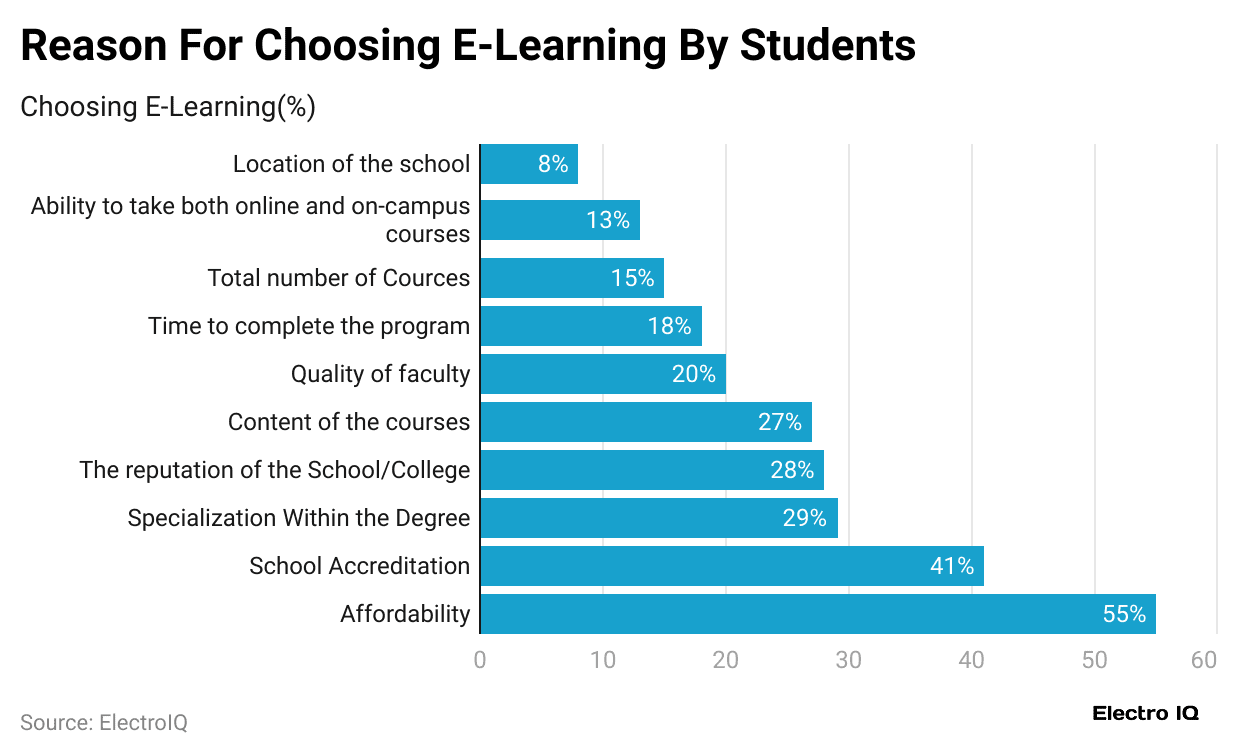
- Over 50% of K-12 students in the United States have taken at least one eLearning course, a number that has grown dramatically in the last five years. This indicates that digital learning is becoming a common part of the academic journey from a young age.
- A survey of college students found that 73% of them would like to continue taking online courses even after returning to in-person classes, valuing the flexibility and convenience that eLearning provides.
- In 2023, approximately 40% of college students stated that eLearning is more effective than traditional classroom instruction for certain subjects, citing the ability to learn at their own pace and review materials as needed.
- Online learners retain 25 to 60% more material compared to their in-person counterparts, according to multiple studies. This is attributed to the ability to control the pace of learning and revisit complex topics.
- The success rate for students in online courses is 72%, a figure that is now on par with or even slightly higher than the success rate in traditional classroom settings.
- It is estimated that 36% of students see the benefits of structured lessons and personalized instruction as a major reason for their preference for eLearning platforms.
- The number of students enrolled in at least one online course at a US university has surpassed 6 million, a clear indicator of the scale and popularity of digital higher education.
- More than half of students who chose online education did so because it was a more affordable option than traditional college, with tuition costs for online programs being significantly lower.
- The average graduation rate for students in online bachelor’s degree programs is 54%, a number that has been steadily improving and is now competitive with in-person programs.
- A major study revealed that 77% of academic leaders rate the learning outcomes of online education as equal to or better than those of face-to-face training, validating the quality of digital education.
- Over 60% of online students are also working full-time, which shows that eLearning is critical for providing educational access to a large and growing population of non-traditional learners.
- Approximately 29% of online graduates earn between $85,000 and $150,000 per year, demonstrating that online degrees lead to competitive and high-paying careers.
- The adoption of eLearning in higher education is considered a crucial long-term strategy by nearly 70% of academic institutions, as they look to expand their reach and cater to a global student body.
- Over 62% of higher education institutions that previously offered only face-to-face classes are now providing some form of online degrees, a testament to the dramatic and lasting shift in the sector.
- The global market for online test preparation services is valued at $13 billion and is growing at a significant rate, reflecting the demand for specialized eLearning tools for academic success.
- eLearning tools in academic settings have been shown to reduce a student’s study time by 30%, as the organized and self-paced nature of the content leads to more efficient learning.
- Over 80% of undergraduate online students have credits that can be applied to their degree, demonstrating the increasing legitimacy and transferability of online coursework.
- The number of universities offering MOOCs has grown by 60% in the past three years, with prestigious institutions like Harvard and MIT leading the way in providing free or low-cost online courses.
- The average tuition for a credit hour at an online college is approximately $250, which is about 30% less than the average tuition for a traditional on-campus course.
- More than 33% of online students are pursuing a degree in business, making it the most popular field of study for remote learners.
| Academic eLearning Statistics | |
| College Students Preferring Online Classes | 73% |
| Increase in Material Retention | 25-60% |
| Online Student Success Rate | 72% |
| Online Students Working Full-Time | Over 60% |
| Academic Leaders Rating Online Outcomes as Good or Better | 77% |
| Increase in Universities Offering MOOCs | 60% |
Key eLearning Trends
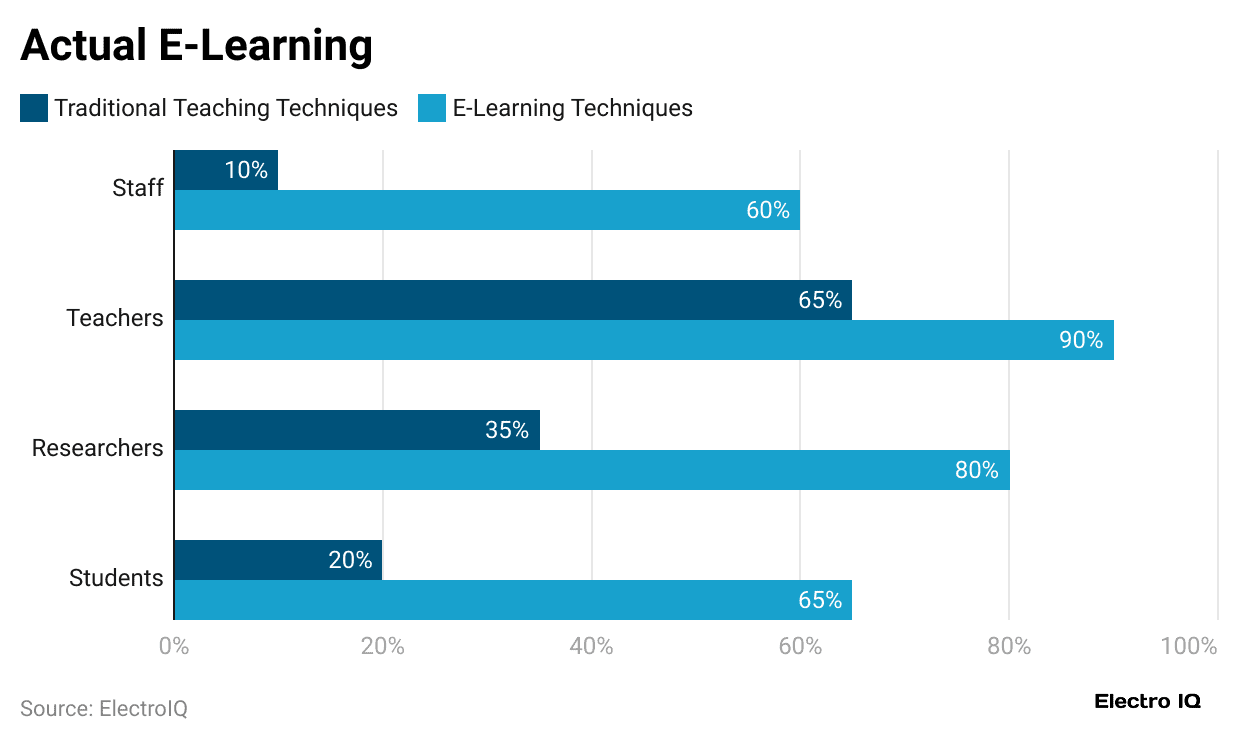
- Gamification in eLearning, which uses game mechanics like leaderboards and points, has been shown to increase user engagement by 55% and improve knowledge retention by up to 18%.
- The use of microlearning, delivering content in short, digestible segments, has been shown to increase learner engagement by 25% and improve knowledge retention by 15%, making it a highly effective method.
- More than 67% of students report that gamified courses are more motivating than traditional ones, as they introduce a competitive and fun element to the learning process.
- The global market for gamification in education is projected to grow from $400 million to over $1.8 billion by 2028, reflecting a significant investment in this learning strategy.
- The global augmented reality (AR) and virtual reality (VR) in eLearning market is expected to grow at a staggering CAGR of 28% by 2030, driven by the increasing use of immersive learning experiences.
- Learners in VR training programs develop soft skills four times faster than those in traditional training settings, according to a recent study by PwC.
- The global AI in education market is projected to reach over $25 billion by 2026, as AI-powered platforms are used for personalized learning paths and automated content creation.
- Personalized learning paths, enabled by data analytics and AI, have been shown to increase learner satisfaction by 40% and improve learning outcomes by an average of 20%.
- Mobile eLearning, also known as mLearning, has become a dominant trend, with over 67% of learners using mobile devices to access their courses.
- The mobile eLearning market is expected to grow at a CAGR of 25% between 2022 and 2028, as the demand for flexible, on-the-go learning continues to rise.
- Studies have shown that students who access eLearning content on their smartphones are 52% more likely to engage with the material after work hours or on weekends.
- The use of social learning platforms is on the rise, with over 70% of corporate L&D teams planning to integrate them into their training strategies.
- eLearning courses that incorporate social learning elements, such as discussion forums or group projects, have completion rates that are 15% higher than those without.
- The global market for educational robotics is valued at over $2 billion, a growing trend that integrates technology into eLearning for subjects like STEM.
- Data analytics tools integrated into eLearning platforms have helped course creators improve their content, with 72% of developers reporting that data insights led to a better user experience.
- The market for digital badges and credentials in eLearning is expected to reach $2.5 billion by 2025, as more employers and learners seek to validate skills acquired through online courses.
- In the realm of language learning, over 500 million people worldwide are using apps like Duolingo, showing a massive shift from traditional language classes to mobile-first eLearning solutions.
- The use of chatbots and virtual assistants in eLearning has been shown to reduce instructor workload by 30% while providing students with instant, personalized support.
- Interactive content, such as quizzes and simulations, has a 20% higher engagement rate than static content like PDFs or video-only lessons.
- The global eLearning market for language acquisition is projected to grow at a CAGR of 19% through 2028, with a heavy emphasis on mobile apps and AI-driven platforms.
| Gamification Increases Engagement | 55% |
| Microlearning Increases in Retention | 15% |
| AR/VR Market Growth Rate (CAGR) | 28% |
| Learners Using Mobile Devices | Over 67% |
| Social Learning Platforms Integration | 70% |
| Chatbots Reducing Instructor Workload | 30% |
Adoption of AI in eLearning
- The AI-powered e-learning subtitle generation segment achieved a market value of USD 1.34 billion in 2024, showing rapid progress in educational technology adoption.
- North America currently dominates the global AI in education landscape due to its strong digital infrastructure and high penetration of AI-based learning tools. The United States leads the region, followed by Europe and Asia Pacific.
- The Asia Pacific region is anticipated to record the fastest growth rate over the coming years. This expansion is supported by broader internet access, continuous digital transformation, and proactive government initiatives promoting smart education.
- In the United States, 26% of students use ChatGPT for academic work, up from 13% in 2023, showing a sharp rise in AI-assisted learning.
- By 2025, 56% of teens familiar with ChatGPT reported using it for school-related tasks, though 73% of teens still do not rely on it for study purposes.
- Around 54% of students consider it appropriate to use ChatGPT for researching new topics, while opinions are mixed for tasks such as math problem-solving and essay writing.
- The survey revealed that 29% find it acceptable for solving math problems and only 18% for writing essays, showing ongoing concerns about academic integrity.
- AI adoption among educators is also increasing, with 3 in 5 teachers (60%) using AI in classrooms to enhance teaching outcomes.
- Most educators apply AI tools to personalize learning experiences and improve engagement among students.
- Younger teachers, especially those under 26 years, display a higher rate of AI adoption compared to older educators.
- AI applications are reducing the administrative workload, potentially cutting teachers’ average weekly preparation time from 11 hours to 6 hours.
- Approximately 51% of teachers utilize AI-powered educational games to keep students engaged.
- About 43% employ adaptive learning platforms to tailor lessons to student performance levels, while 35% use chatbots for academic support and feedback.
- 41% of educators rely on automated grading systems to save time on assessments, and 29% implement intelligent tutoring systems for guided learning experiences.
- A small portion, 5%, use other AI tools, while 6% report not using any AI-based tools in classrooms, and 3% remain unsure about their AI adoption level.
| Usage of AI | Percentage of teachers |
|---|---|
| AI-powered educational games | 51% |
| Adaptive learning platforms | 43% |
| Automated grading and feedback system | 41% |
| Chatbots for student support | 35% |
| Intelligent tutoring systems | 29% |
| Other | 5% |
| No AI-based tools used | 6% |
| Not sure | 3% |
The Lasting Impact of COVID-19 on eLearning
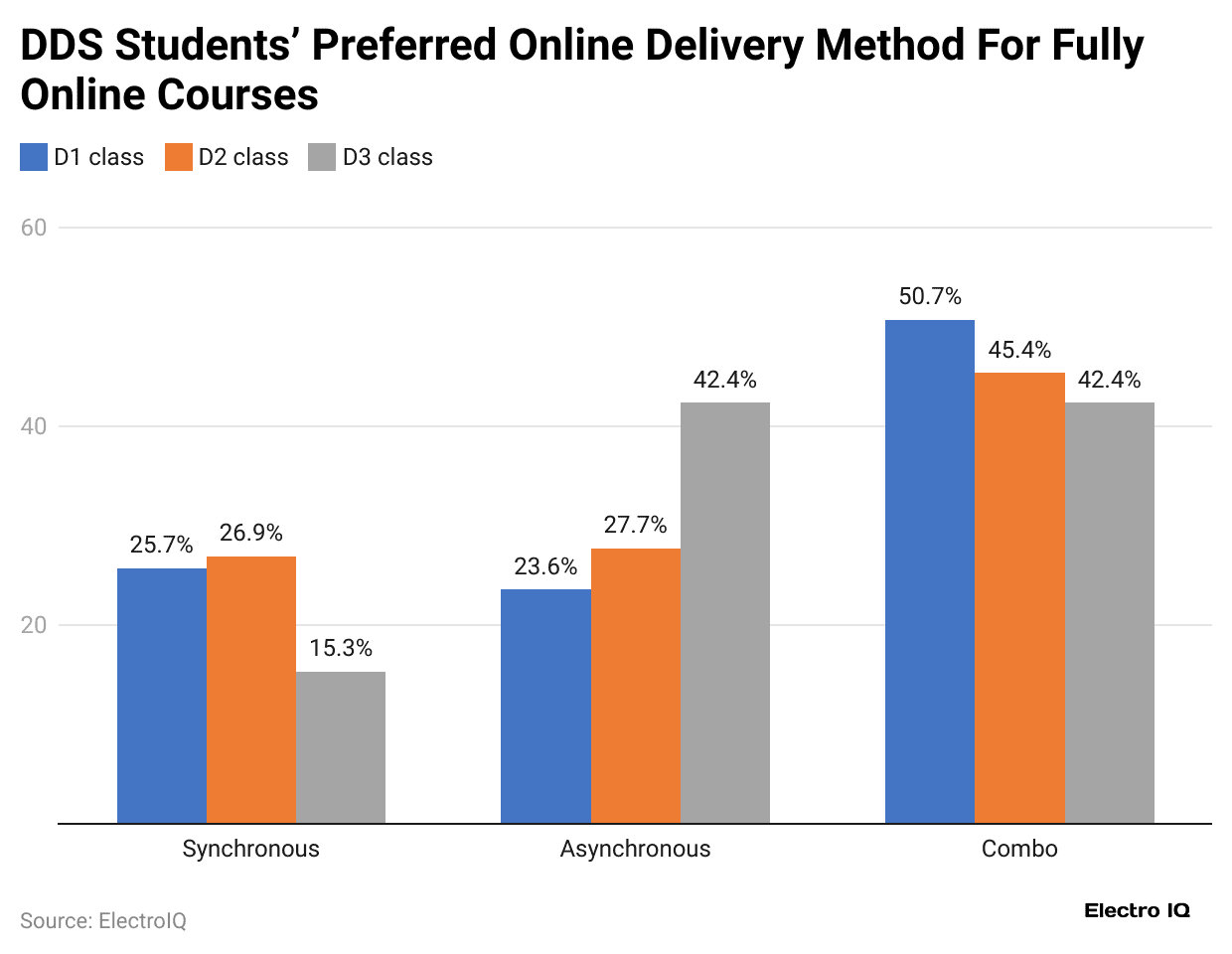
- During the height of the pandemic, there was an unprecedented 900% increase in global internet search interest for eLearning, reflecting a mass migration to online education.
- A survey found that 59% of respondents said the pandemic made them consider enrolling in an eLearning course for the first time, leading to a massive influx of new users.
- Over 43% of educational institutions worldwide began to explore and implement eLearning modules for efficient learning and to ensure continuity of education during lockdowns.
- The number of users on major eLearning platforms like Coursera grew by 438% in just five years, with a significant portion of that growth occurring during the pandemic.
- A staggering 98% of examinations around the world are now conducted in an online or hybrid format, a direct result of the pandemic-driven shift in assessment methods.
- 58% of employees reported that the pandemic changed their perspective on professional development, making them more open to flexible and self-paced eLearning courses.
- The market for mobile eLearning saw a 35% increase in revenue in 2020 alone, as people turned to their smartphones and tablets for learning while at home.
- A survey of US students found that 73% would like to continue online classes even after the pandemic is over, valuing the newfound flexibility and convenience.
- In 2020, there was a 40% increase in the number of free courses offered by major eLearning platforms, as they worked to provide educational resources during a time of crisis.
- The total number of learners using MOOCs increased by 120% from 2019 to 2021, with enrollments on platforms like Coursera and edX skyrocketing.
- The demand for digital skills training saw a massive spike, with 65% of companies increasing their eLearning budgets to equip employees with the skills needed to work remotely.
- The adoption of eLearning in higher education increased by 300% between 2019 and 2021, as institutions were forced to pivot from on-campus to online classes.
- Nearly 70% of university administrators believe that a hybrid model of learning, combining online and in-person instruction, will become the new normal for higher education.
- The global remote learning market grew by 250% in 2020, with eLearning being the primary vehicle for this growth.
- A survey of parents found that 82% of them believe that digital learning tools are beneficial for their children’s education and should continue to be used in the future.
- The global investment in EdTech, which includes eLearning startups, more than doubled in 2020 compared to the previous year.
- The completion rate for online courses, which was a major concern before the pandemic, saw a 15% increase as more learners became accustomed to the format.
- Approximately 55% of companies that had not previously used eLearning reported that the pandemic was the primary reason they decided to adopt it for their workforce.
- A significant 48% of workers stated that they would prefer to work for a company that offers a robust eLearning program, showcasing how digital training has become a major factor in job selection.
- The global online corporate training market grew by 12% in 2020 alone, driven by the need for remote training and upskilling during the pandemic.
| Impact of COVID-19 on eLearning | |
| Increase in Search Interest for eLearning | 900% |
| New Users Considering eLearning | 59% |
| Increase in Users on Major Platforms | 438% |
| Online Examinations Worldwide | 98% |
| Increase in EdTech Investment | Over 100% |
| Workers Preferring Companies with eLearning | 48% |
eLearning Statistics by Country
- The online education market in the United States is projected to generate $99.84 billion in revenue by the end of 2025.
- The revenue is expected to increase at an annual rate of 9.64%, reaching $144.29 billion by 2029.
- Each user in the U.S. is expected to contribute an average of $1,490 in revenue during 2025.
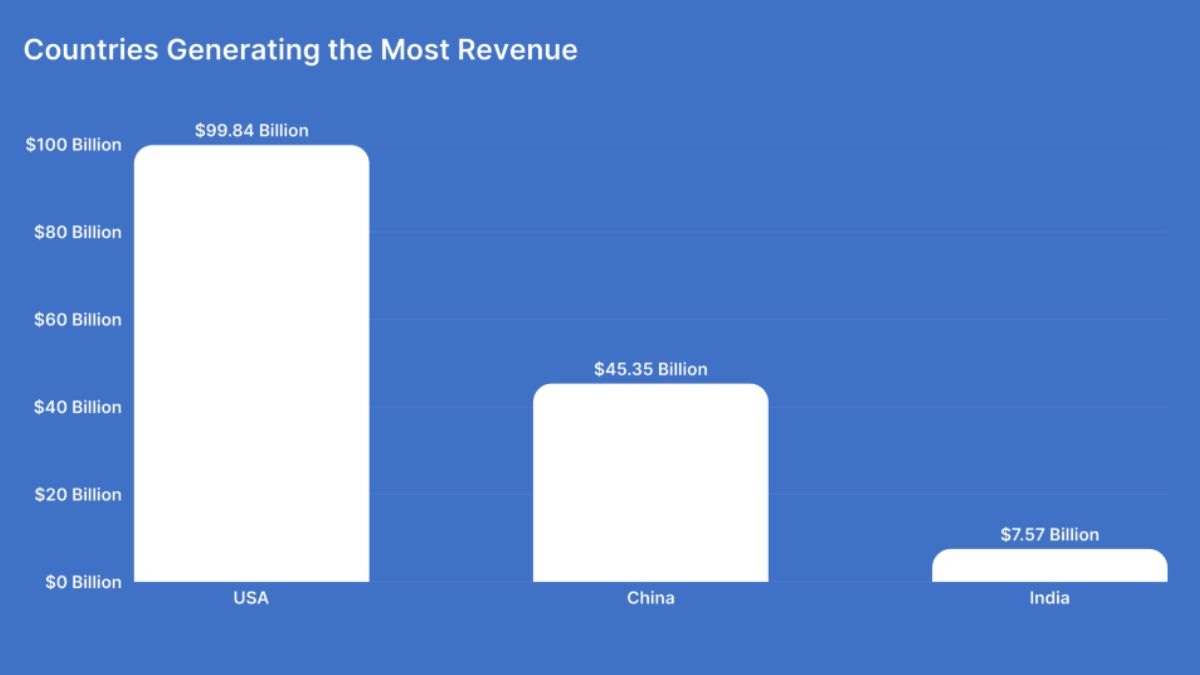
- The total number of online learners in the country is anticipated to reach 87.6 million by 2029.
- The user penetration rate in the U.S. online education market is projected to reach 19.5% by the end of 2025.
- China stands as the second-largest eLearning market globally, following the United States.
- The revenue of China’s online education market is estimated to reach $45.35 billion by 2025.
- The market is expected to experience a marginal growth rate of 0.03% between 2025 and 2029, leading to a total market value of $45.40 billion by 2029.
- The average revenue per user in China’s online education sector is predicted to reach $140.90 in 2025.
- The eLearning market in India is projected to reach $7.57 billion in revenue by 2025.
- The market is expected to expand rapidly, growing at a 25.76% CAGR, and reaching $18.94 billion by 2029.
- India’s online learning platform segment alone is expected to reach $6.20 billion by 2025.
- The average revenue per user is expected to stand at $34.62 in 2025.
- The total number of online learners in India is projected to reach 309.1 million by 2029.
- The user penetration rate in India’s online education sector is estimated at 15.0% by 2025.
- The eLearning market in the United States had already reached $100 billion in 2022, positioning it as the largest globally.
- This figure is projected to climb to nearly $687 billion by 2030, reflecting steady expansion.
- In comparison, the United Kingdom’s online education revenue is expected to grow to $14.6 billion by 2028, supported by an average revenue per user of $0.89k in 2024.
- By 2028, the U.K. is expected to have around 15.1 million online learners.
- China’s market, valued at $171 billion by 2030, continues to demonstrate its increasing influence within the global eLearning landscape.
Leading eLearning Platforms
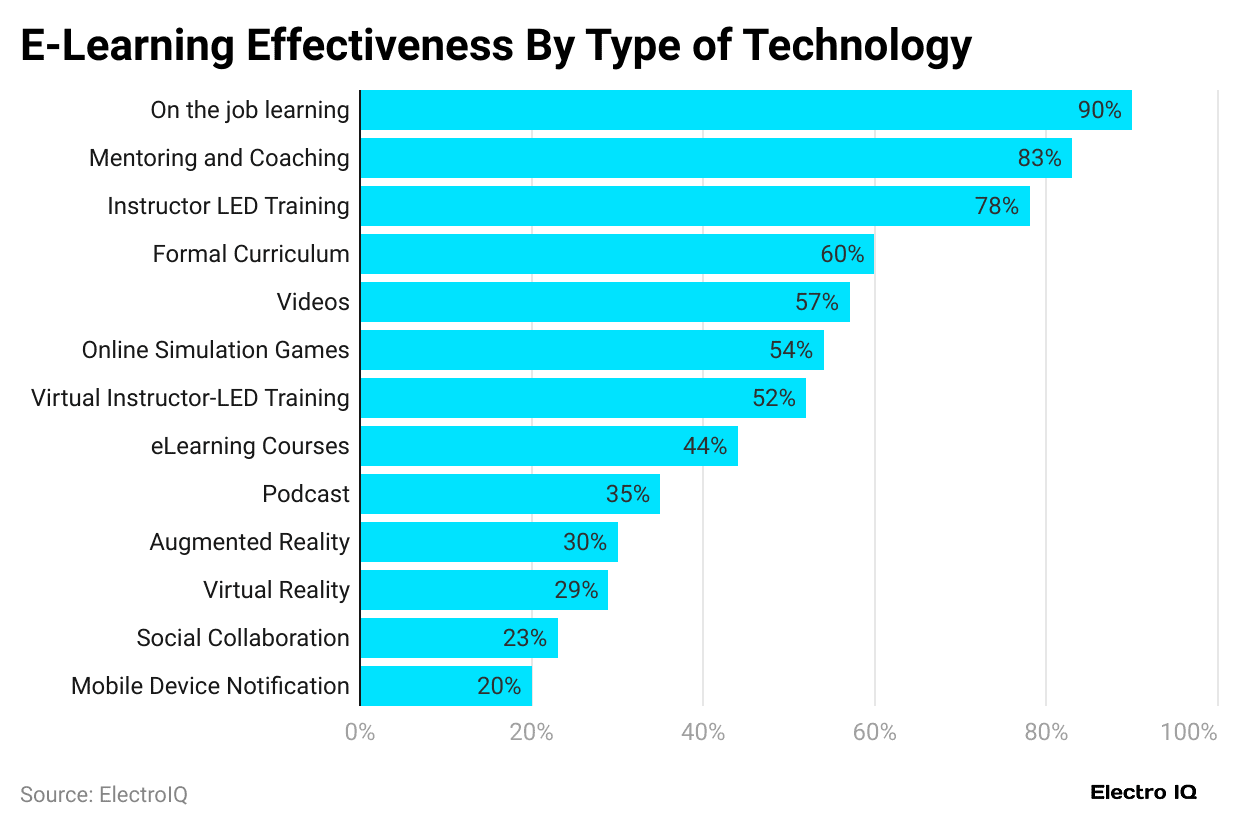
- Udemy is a market leader with a user base of over 52 million students and a vast library of over 196,000 courses, making it a go-to platform for individuals and corporations seeking diverse skills.
- Coursera has over 82 million registered users and offers a catalog of more than 3,500 courses, including specialized content from 29 globally recognized universities.
- Skillshare focuses on creative and professional skills, boasting a user base of approximately 12 million and a library of over 35,000 classes, catering to a niche but dedicated audience.
- edX, a non-profit organization founded by Harvard and MIT, has over 45 million users and offers more than 4,000 online courses from top global institutions.
- LinkedIn Learning has a library of over 16,000 courses and is a preferred platform for corporate clients, as it offers seamless integration with professional networking.
- Duolingo, the popular language-learning app, has over 500 million users worldwide, making it the most downloaded educational app globally and a benchmark for language e-learning.
- Masterclass has a highly curated selection of over 150 courses taught by world-renowned experts, and it has successfully carved out a profitable niche in the premium eLearning market.
- The global eLearning platforms market is projected to reach $28 billion by 2026, with the top platforms continuing to hold the lion’s share of revenue and user traffic.
- Udemy instructors have earned over $1 billion through the platform, showcasing the financial viability and massive scale of the creator economy within eLearning.
- The top 500 instructors on Skillshare earn an average of over $2,000 per month, demonstrating the potential for professionals to monetize their skills through digital teaching.
- The average course completion rate on platforms like Coursera is approximately 13%, a figure that highlights the challenge of maintaining user engagement in self-paced learning.
- Teachable, a platform for creating and selling online courses, has over 35 million users and has helped instructors generate over $500 million in sales, showing the growing power of independent eLearning entrepreneurs.
- The user penetration of online learning platforms is expected to be 11.6% globally by 2023, and it is projected to grow to 16.6% by 2027.
- Approximately 90% of courses on platforms like Udemy are paid, while a majority of courses on non-profit platforms like edX and Khan Academy are free.
- BYJU’s Learning, an Indian-based eLearning app, has over 100 million downloads and more than 6.5 million subscribers, making it one of the largest educational apps in the world.
- Khan Academy offers free education in over 50 languages and is used by more than 48 million users in 190 countries, demonstrating its mission of universal, free education.
- SoloLearn, a popular coding education app, has a user base of over 21 million learners and offers courses in 25 different programming languages.
- Coursera reported a significant increase in its corporate learning division, with over 2,000 companies using its platform for employee training.
- In 2022, Udemy saw its revenue grow by 25% year over year, a clear sign of the continued profitability of the e-learning platform market.
- Quizlet, a study tool platform, has a user base of over 50 million active learners and has raised over $40 million in funding, showing that even niche learning tools can achieve massive scale.
| Leading eLearning Platforms | |
| Udemy Student Base | Over 52 Million |
| Coursera Registered Users | Over 82 Million |
| Duolingo Total Users | Over 500 Million |
| LinkedIn Learning Courses | Over 16,000 |
| BYJU’s Learning Subscribers | Over 6.5 Million |
| Teachable Total Instructor Earnings | Over $500 Million |
Challenges and the Future of eLearning
- The average completion rate for MOOCs and other self-paced eLearning courses is less than 13.3%, a key challenge that platforms are actively trying to solve through better engagement features.
- A recent survey showed that 58% of learners reported technical issues as a major challenge in their eLearning journey, highlighting the need for more robust and user-friendly platforms.
- Approximately 40% of learners cite a lack of personalized feedback as a major drawback of eLearning, showing that even with automation, human interaction is still highly valued.
- Over 33% of corporate learners feel a lack of social interaction in eLearning, which can be a barrier to collaborative learning and networking.
- The global market for proctoring services in eLearning is expected to reach $1.8 billion by 2028, reflecting the ongoing challenge of ensuring academic integrity and security in online exams.
- In 2023, over 60% of educational institutions reported that a lack of adequate digital infrastructure was the biggest obstacle to a full-scale adoption of eLearning.
- The market for AI-driven tutoring services is projected to grow to over $5 billion by 2028, a response to the demand for personalized learning experiences that can scale.
- The average amount of money spent on eLearning content development has increased by 15% year over year, as companies and institutions invest more in creating high-quality, engaging courses.
- The global market for EdTech cybersecurity is expected to reach $8 billion by 2028, reflecting the growing concern over data privacy and security in the e-learning ecosystem.
- It is estimated that 73% of students are still unaware of what MOOCs are, showing a major gap in marketing and awareness for these large-scale online courses.
- The use of adaptive learning platforms is expected to grow by 25% in the next three years, as more companies and schools seek to provide content that adjusts to a learner’s individual pace and skill level.
- Approximately 55% of learners who dropped out of an online course cited a lack of motivation as the main reason, indicating that engagement remains a critical factor for success.
- The eLearning market for K-12 is projected to grow by 20% between 2023 and 2028, as technology becomes more integrated into the standard school curriculum.
- Over 65% of corporate L&D professionals believe that a blended learning approach, combining digital and in-person training, is the most effective way to train employees.
- The market for corporate compliance training is projected to grow by 10% annually, with eLearning being the primary delivery method due to its efficiency and cost-effectiveness.
- A notable 29% of online graduates now earn between $85,000 and $150,000, a statistic that proves the value and return on investment for digital degrees.
- Over 77% of academic leaders rate the learning outcomes of online education as equal to or better than those from traditional, face-to-face training.
- The number of online courses offered by top universities has increased by 40% in the last two years, as institutions expand their digital offerings to a wider audience.
- The global market for language eLearning apps is expected to surpass $15 billion by 2027, driven by a growing global demand for multilingual skills.
- A majority of users, over 87%, use their mobile phones to look for online courses, showcasing the dominance of mobile devices in the eLearning search and discovery process.
| Average MOOC Completion Rate | Less than 13.3% |
| Learners Reporting Technical Issues | 58% |
| Learners Citing Lack of Personalized Feedback | 40% |
| Projected AI Tutoring Market | Over $5 Billion |
| Online Graduate Income | 29% Earn $85k to $150k |
| Mobile Search for Courses | Over 87% |
Conclusion
Overall, this detailed look into the world of eLearning statistics shows an industry that is constantly evolving. From its origins to its current status as a trillion-dollar industry, the data prove that digital learning is a powerful force for change. It is changing how we gain knowledge, from the classroom to the boardroom, and its influence will only continue to grow forever into another dimension.
FAQ.
The global eLearning market was valued at over $400 billion in 2023, showing its immense scale and economic importance.
The market is projected to reach a valuation of over $1 trillion by 2032, a rapid increase driven by technology and demand for flexible learning.
Yes, over 90% of Fortune 500 companies use some form of eLearning for employee training, citing its efficiency and cost-effectiveness.
Yes, learners in eLearning courses can retain 25% to 60% more material and reduce training time by up to 45% compared to traditional classroom methods.
The pandemic acted as a major catalyst, causing a 900% increase in global search interest for eLearning and accelerating its adoption by both institutions and individuals.
Key benefits include improved employee productivity by 26%, a 21% increase in employee satisfaction, and significant cost savings. It is also more flexible and accessible.
Yes, a survey of US students found that 73% would like to continue taking online courses even after the pandemic due to the flexibility and convenience.
Major trends include gamification, which boosts engagement by 55%, and the use of microlearning, which improves knowledge retention by 15%. AI and mobile learning are also growing rapidly.
No, a typical eLearning course can cost approximately $150 per employee, a fraction of the $1,200 average cost for a traditional, in-person training session.
A MOOC, or Massive Open Online Course, is a large-scale online course, often offered for free or at a low cost by major universities. The MOOC market is expected to reach a value of $25 billion by 2025.

Jeeva Shanmugam is passionate about turning raw numbers into real stories. With a knack for breaking down complex stats into simple, engaging insights, he helps readers see the world through the lens of data—without ever feeling overwhelmed. From trends that shape industries to everyday patterns we overlook, Jeeva’s writing bridges the gap between data and people. His mission? To prove that statistics aren’t just about numbers, they’re about understanding life a little better, one data point at a time.




